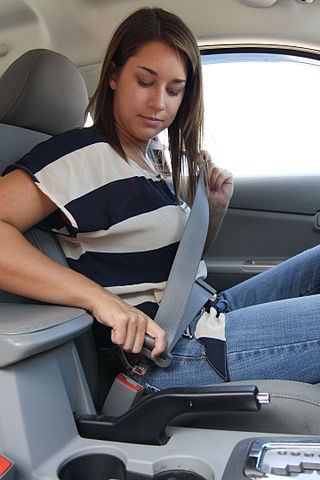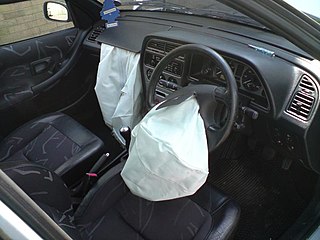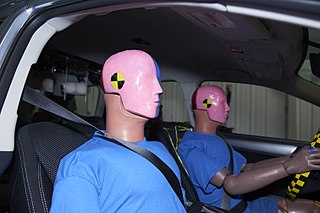
A seat belt, also known as a safety belt or spelled seatbelt, is a vehicle safety device designed to secure the driver or a passenger of a vehicle against harmful movement that may result during a collision or a sudden stop. A seat belt reduces the likelihood of death or serious injury in a traffic collision by reducing the force of secondary impacts with interior strike hazards, by keeping occupants positioned correctly for maximum effectiveness of the airbag, and by preventing occupants being ejected from the vehicle in a crash or if the vehicle rolls over.

An airbag is a vehicle occupant-restraint system using a bag designed to inflate extremely quickly, then quickly deflate during a collision. It consists of an airbag cushion, a flexible fabric bag, an inflation module, and an impact sensor. The purpose of the airbag is to provide a vehicle occupant with soft cushioning and restraint during a collision. It can reduce injuries between the flailing occupant and the interior of the vehicle.

A crash test dummy, or simply dummy, is a full-scale anthropomorphic test device (ATD) that simulates the dimensions, weight proportions and articulation of the human body during a traffic collision. Dummies are used by researchers, automobile and aircraft manufacturers to predict the injuries a person might sustain in a crash. Modern dummies are usually instrumented to record data such as velocity of impact, crushing force, bending, folding, or torque of the body, and deceleration rates during a collision.

Whiplash is a non-clinical term describing a range of injuries to the neck caused by or related to a sudden distortion of the neck associated with extension, although the exact injury mechanisms remain unknown. The term "whiplash" is a colloquialism. "Cervical acceleration–deceleration" (CAD) describes the mechanism of the injury, while the term "whiplash associated disorders" (WAD) describes the subsequent injuries and symptoms.

Crumple zones, crush zones, or crash zones are a structural safety feature used in vehicles, mainly in automobiles, to increase the time over which a change in velocity occurs from the impact during a collision by a controlled deformation; in recent years, it is also incorporated into trains and railcars.

A crash test is a form of destructive testing usually performed in order to ensure safe design standards in crashworthiness and crash compatibility for various modes of transportation or related systems and components.

Automotive safety is the study and practice of automotive design, construction, equipment and regulation to minimize the occurrence and consequences of traffic collisions involving motor vehicles. Road traffic safety more broadly includes roadway design.

The Saab 9-5 is an executive car that was produced by the Swedish automobile maker Saab from 1997 to 2012.

A bumper is a structure attached to or integrated with the front and rear ends of a motor vehicle, to absorb impact in a minor collision, ideally minimizing repair costs. Stiff metal bumpers appeared on automobiles as early as 1904 that had a mainly ornamental function. Numerous developments, improvements in materials and technologies, as well as greater focus on functionality for protecting vehicle components and improving safety have changed bumpers over the years. Bumpers ideally minimize height mismatches between vehicles and protect pedestrians from injury. Regulatory measures have been enacted to reduce vehicle repair costs and, more recently, impact on pedestrians.

The European New Car Assessment Programme is a European voluntary car safety performance assessment programme based in Leuven, Belgium. Formed in 1996, the first results were released in February 1997. It was originally started by the Transport Research Laboratory for the UK Department for Transport but later backed by several European governments, as well as by the European Union (EU). Their slogan is "For Safer Cars".
Seat belt legislation requires the fitting of seat belts to motor vehicles and the wearing of seat belts by motor vehicle occupants to be mandatory. Laws requiring the fitting of seat belts to cars have in some cases been followed by laws mandating their use, with the effect that thousands of deaths on the road have been prevented. Different laws apply in different countries to the wearing of seat belts.

The Insurance Institute for Highway Safety and Highway Loss Data Institute (IIHS-HLDI) is an American nonprofit organization. It was established in 1959, and it is noted for its safety reviews of vehicles in various simulated traffic situations, including the effectiveness of a vehicle's structural integrity and safety systems during a collision, in addition to examining improvement on such elements.

A child safety seat, sometimes called an infant safety seat, child restraint system, child seat, baby seat, car seat, or a booster seat, is a seat designed specifically to protect children from injury or death during vehicle collisions. Most commonly these seats are purchased and installed by car owners, but car manufacturers may integrate them directly into their vehicle's design and generally are required to provide anchors and ensure seat belt compatibility. Many jurisdictions require children defined by age, weight, and/or height to use a government-approved child safety seat when riding in a vehicle. Child safety seats provide passive restraints and must be properly used to be effective. However, research indicates that many child safety restraints are often not installed or used properly. To tackle this negative trend, health officials and child safety experts produce child safety videos to teach proper car seat installation to parents and caregivers.

Head restraints are an automotive safety feature, attached or integrated into the top of each seat to limit the rearward movement of the adult occupant's head, relative to the torso, in a collision — to prevent or mitigate whiplash or injury to the cervical vertebrae. Since their mandatory introduction in some countries beginning in the late 1960s, head restraints have prevented or mitigated thousands of serious injuries.

Whiplash Protection System (WHIPS) is a system to protect against automotive whiplash injuries introduced by Volvo in 1998. It was launched when the Volvo S80 was released for the 1999 model year and has since been part of the standard equipment of all new Volvo cars.
Reinforced Impact Safety Evolution (RISE) or Realized Impact Safety Evolution is the brand name of Mitsubishi's patented safety body construction system. It was first introduced in the 1996 Mitsubishi Galant. Initially designed to improve passive safety, the system has subsequently been developed to electronically integrate every aspect of car's active and passive safety features.

Out of position (OOP), in crash testing and car accident medical literature, indicates a passenger position which is not the normal upright and forward-facing position. For example, a common case observed in crashes is the position of an occupant when reaching for the car radio, or panic braking in unbelted passengers. The concept is of interest because small changes in a passenger's position can have profound effects on the actual kinematic response, especially in rear impacts, as shown both in practical testing and theoretical models.

A traffic collision, also known as a motor vehicle collision, occurs when a vehicle collides with another vehicle, pedestrian, animal, road debris, or other moving or stationary obstruction, such as a tree, pole or building. Traffic collisions often result in injury, disability, death, and property damage as well as financial costs to both society and the individuals involved. Road transport is the most dangerous situation people deal with on a daily basis, but casualty figures from such incidents attract less media attention than other, less frequent types of tragedy. The commonly used term car accident is increasingly falling out of favor with many government departments and organizations, with the Associated Press style guide recommending caution before using the term. Some collisions are intentional vehicle-ramming attacks, staged crashes, vehicular homicide or vehicular suicide.
When a person makes a claim for personal injury damages that have resulted from the presence of a defective automobile or component of an automobile, that person asserts a product liability claim. That claim may be against the automobile's manufacturer, the manufacturer of a component part or system, or both, as well as potentially being raised against companies that distributed, sold or installed the part or system that is alleged to be defective.

The RS-platform Chrysler minivans are a short- and long-wheelbase passenger minivans marketed by Chrysler from model years 2001–2007, as the fourth generation Chrysler minivans, heavily revised versions of their predecessors, the NS minivans.

















